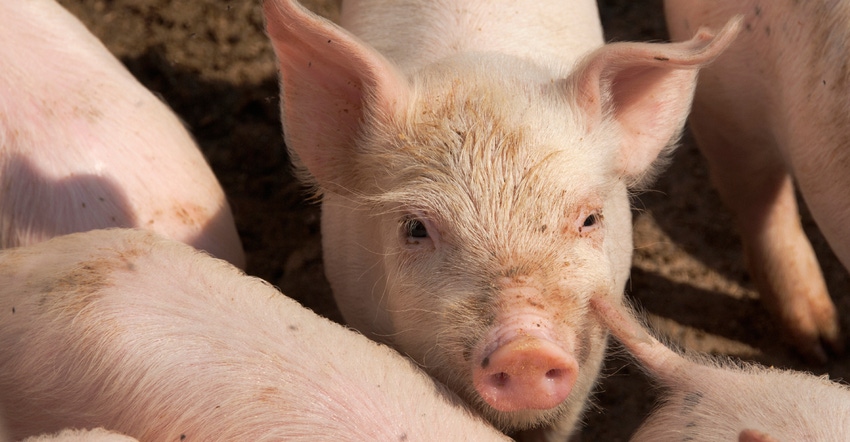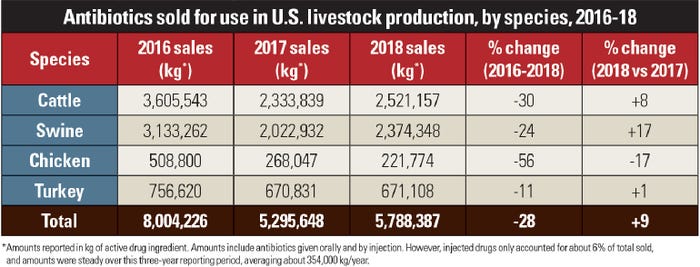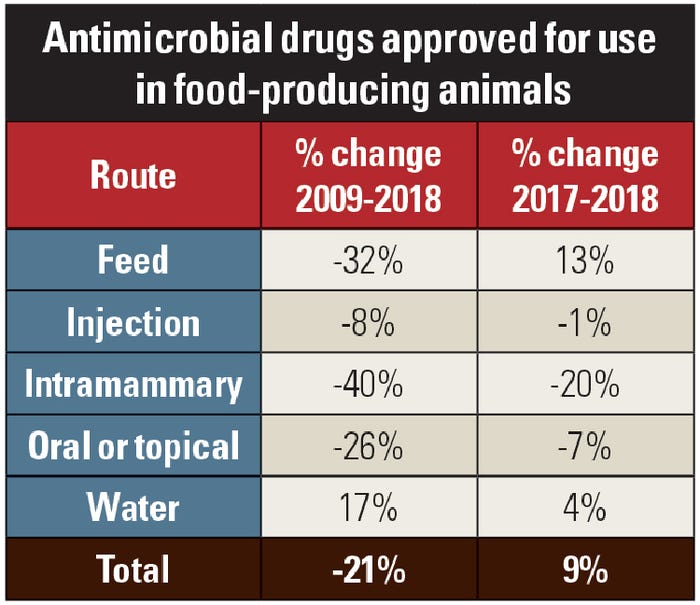Specialists: Uptick of Med Am use in livestock is not a trend
Seasonality, herd health fluctuations and increases in respiratory issues are possible explanations.
December 28, 2020

The most recent data on the sale of medically important antibiotics for food-producing animals is the 2018 Summary Report released in December 2019. Examining year-over-year sales provides the ability to track industry trends, which assists with understanding the issues related to farm livestock health and management practices.
Medically important antimicrobials (Med Am) are those in which the same class of drugs are used in humans as well as in animals. It is believed that reducing the use of such in animals will reduce resistance to these drugs in humans.
This belief has brought about major changes in the animal agriculture industry as farmers who are involved with growing and raising animals for food proteins work to deliver the safest product possible for the consumer.
This report functions as a gauge for industry groups representing agriculture, including the U.S. Pork Producers, Cattleman’s Associations, dairy cooperatives and others to compare yearly usage reports and helps determine if further efforts are needed to decrease the use of Med Am.
In 2016, the Food and Drug Administration implemented directives that resulted in significant changes in use of Med Am for food production animals. These changes included how medication use was determined and justified so that usage was based on treatment of a disease.
The end result of this modification is that the use of Med Am, when no disease was known to occur, has decreased to almost zero. Changes also included enhanced veterinary supervision, which is now required for use of Med Am in all animals raised for food proteins through the use of veterinary feed directives (VFD).
FDA tracks sales and distribution records for all antimicrobials used for veterinary purposes to estimate the amount of each class of antibiotic used in animals. The FDA Summary Report for 2018 shows that, when data is combined for all Med Am sales for all species of livestock, the amount (reported as total weight, not number of doses) increased by 9% over 2017 (see table below).

The use of Med Am in all animal species dropped significantly from 2016. However, in some animal groups, there has been an increase over 2017 usage. For example, with pigs, the year-over-year increase was about 17% (increased by 351,416 kilograms) and with cattle an 8% increase (187,318 kilograms). Cattle and swine account for 81% of all Med Am use in food animal production.
Pork industry
When we take a closer look at Med Am sales, most of the increase in sales of medically important antibiotics used for pork production in 2018 came from sale of tetracyclines, especially chlortetracycline and oxytetracycline.
Tetracyclines make up almost two-thirds of all Med Am sales for food animal production, and account for about 80% of the total U.S. market for feed grade antibiotics used in pigs during the past several years. Sales of tetracyclines for use in swine increased 21% from 2017 to 2018.
While much smaller in volume than tetracyclines, sales of aminoglycoside and sulfa-containing antibiotics for use in swine also increased by greater than 40% in 2018, while lincosamides declined by 19%.
However, their net impact on total antibiotic sales for swine was small because amounts of these three classes combined was less than 6% of the tetracyclines. Although knowing why we see the increase in sales and distribution of Med Am for swine is not confirmed, we can look at changes in seasonality, herd health fluctuations and increases in respiratory issues as possible explanations for this documented growth.
Cattle industry
Regarding the cattle that were fed antibiotics requiring a veterinary feed directive, there also is a slight uptick in sales and distribution data. Tetracyclines are again seen with an increase of 11% for use in cattle from 2017 to 2018. Lincosamides are not used in cattle, and sulfa drugs continued to decrease for cattle sales, but aminoglycosides also were up 10% year-over-year.
Like swine, there are several plausible reasons for the increase in sales and distribution of Med Am in the cattle industry. Med Am products may have been prescribed for dairy calves that developed respiratory disease because of seasonal stress or exposure, or in a beef feedlots when cattle are moved — and exposure, in combination with stress, increases respiratory problems.
FDA also tracks Med Am products that are administered as injectables or for intramammary use (see table below). Total injectable use declined slightly (1%) from the previous year, and intramammary use (likely dairy cattle only) declined a further 20% over 2017.

Decreased administration of Med Am as injectables indicates that individual sick animal treatment has not likely increased, and the decreased use via intramammary treatment is further testament that mastitis continues to decline as more farms with very good mastitis control elect to practice selective rather than blanket dry cow treatment.
While we do see an uptick in sales and distribution of Med Am from 2017 to 2018 for food producing animals, this cannot yet be considered a trend. The increased ability to track this type of data allows questions to be asked, while we wait for trends to develop.
Looking into this, we may start to ask, “What are the possible reasons for the 2018 uptick in feed and water administered Med Am sales for use in swine and cattle production?”
Understanding the data
We are left with looking at possible scenarios for explanations. For the swine industry, this can include increased U.S. herd size, increased average slaughter weight, increased incidence of disease, less labor or less experienced labor, and other market dynamics.
The most likely result is that each of these may have contributed a portion of the gains. What we do know is that slaughter hog numbers, average weight of hogs at slaughter, and weight of pork produced are key end points tracked carefully by USDA, and each of these indicators also increased between 2017 and 2018.
Another possible explanation for why sales and delivery of certain classes of medically important antibiotics increased is that these antibiotics were purchased in order to prevent or treat disease conditions that may have seen small increases in 2017 and 2018.
Based on a 2018 national survey initiated by MSU Extension, 31% of swine producers who responded reported an increase in disease following implementation of VFD guidelines, and 18% said they would like to learn more about non-antibiotic options for sick animals (follow-up action most frequently requested in the survey). In this survey, similar results were reported for cattle, which also showed an increase in antibiotic sales in 2018.
Even though 2018 saw increased use of Med Am over the previous year, 96% of that use was under the direction of a veterinarian designated as having a relationship with the farm. While it is useful to pay attention to year-over-year antibiotic sales data, it is also important to recognize that results from one year don’t necessarily indicate a new trend.
Along with this data, it is important to understand that numerous factors influence when and how antibiotics are used to combat disease in pigs and other livestock.
Despite the uptick, FDA data suggest overall use in 2018 of medically important antibiotics in livestock was still the second-lowest, for the year, since 2009 when this metric for antibiotic sales to livestock producers was first reported.
These findings demonstrate that, in spite of the modest increase reported in 2018, overall use of antibiotics for swine and cattle production — when normalized against pounds of pork, beef and milk produced — remains well below historical averages, and suggests U.S. farmers remain committed and on the right track in their antibiotic stewardship efforts.
Dave Thompson is an MSU Extension swine educator. He can be contacted at [email protected] or 517-279-6414. Phil Durst is an MSU Extension educator who focuses on dairy and beef cattle health and production. He can be contacted at [email protected] or 989-345-0692. Beth Ferry is an MSU Extension swine educator. She can be contacted at [email protected] or 269-927-5674.
Source: Michigan State University Extension, which is solely responsible for the information provided and is wholly owned by the source. Informa Business Media and all its subsidiaries are not responsible for any of the content contained in this information asset.
You May Also Like



